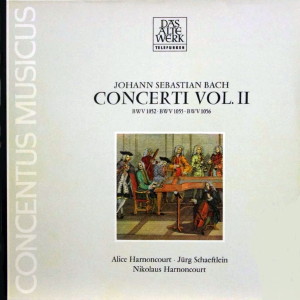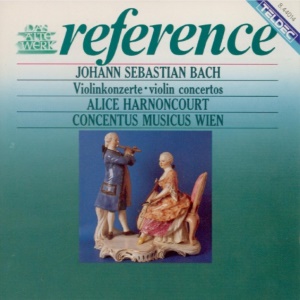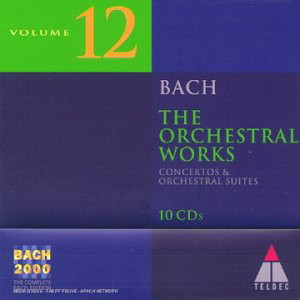 |
1 LP -
6.42032 AW - (p) 1977
|
 |
| 1 CD -
8.44014 ZS - (c) 1988 |
 |
| 10 CD -
3984-25717-2 - (c) 1999 |
|
| Johann
Sebastian Bach (1685-1750) |
|
|
|
|
|
|
|
| Konzert für Violine g-moll |
|
9' 47" |
A1 |
(Rekonstruktion nach dem
Cembalokonzert BWV 1056)
|
|
|
|
| - (Allegro) |
3' 35" |
|
|
- Largo
|
2' 37" |
|
|
| - Presto |
3' 35" |
|
|
| Konzert
für Oboe d'amore A-dur |
|
14' 02" |
A2 |
| (Rekonstruktion nach dem
Cembalokonzert BWV 1055) |
|
|
|
| - (Allegro) |
4' 38" |
|
|
- Larghetto
|
5' 09"
|
|
|
| - Allegro ma non Tanto |
4' 15" |
|
|
| Konzert
für Violine d-moll |
|
21' 32" |
B |
| (Rekonstruktion nach dem
Cembalokonzert BWV 1052) |
|
|
|
| - (Allegro) |
7' 25" |
|
|
- Adagio
|
6' 13" |
|
|
| - Allegro |
7' 54" |
|
|
|
|
|
|
Alice Harnoncourt,
Violine
|
|
Jürg
Schaeftlein, Oboe d'amore
|
|
|
|
CONCENTUS MUSICUS
WIEN (mit Originainstrumenten)
|
|
| -
Jürg Schaeftlein, Oboe d'amore |
-
Veronika Schmidt, Violine (1) |
|
| -
Alice Harnoncourt, Violine (Solo
1,2; tutti 3) |
-
Josef de Sordi, Violine (2,3),
Viola (1)
|
|
| -
Walter Pfeiffer, Violine |
-
Kurt Theiner, Viola |
|
| -
Peter Schoberwalter, Violine |
-
Nikolaus Harnoncourt, Violoncello |
|
| -
Wilhelm Mergl, Violine |
-
Eduard Hruza, Violone |
|
-
Anita Mitterer, Violine (1)
|
-
Herbert Tachezi, Cembalo |
|
|
|
| Nikolaus Harnoncourt, Leitung |
|
|
Luogo
e data di registrazione
|
| 1976 |
|
Registrazione
live / studio
|
| studio |
Producer
/ Engineer
|
-
|
Prima Edizione CD
|
Teldec
"reference" - 8.44014 ZS - (1 cd) - 49'
09" - (c) 1988 - AAD - (BWV 1056)
Teldec "Bach 2000" - 3984-25717-2 - (10
cd) - 35' 38" - (c) 1999 - ADD - (BWV
1055, 1052)
|
Prima
Edizione LP
|
Telefunken "Das
Alte Werk" - 6.42032 AW -
(1 lp) - 45'
21"
- (p) 1977
|
|
|
Notes
|
What distinguishes the
Violin Concerto in D minor from
its sister works is the decidedly
virtuoso flavour of the solo part,
which has to resolve such exacting
violin techniques as arpeggios
spreading over two octaves, bariolage
figures (changing from open strings
and stopped tones), broken intervals
in semiqtuavers
and rapidly changing double-stopping.
In addition to
indications construed from the
autograph of the harpsichord
version, it was primarily these violin
performance practice figures
which gave a clear idea of the
original design of the work. The first
movement is particularly conspicuous
for its outstanding unisonal theme
which, because of its thrice repeated
syncopation accumulation and varied
immanent harmony, was regarded as a
bold invention for that
period. The close interlinking of
tutti passages (ritornellos) and solo
parts - this is specifically achieved
by the tutti parts
(ripieno parts) accompanying the
soloist in the solo episodes with
segments of the ritornello theme -
makes the movement a text book example
of Bach`s art of motif work.
The second movement (Adagio) is to a
large extent marked by the ritornello
theme in G minor, which again is
performed unisono. It
is present in every bar of the
movement as "basso quasi ostinato”
(entirely within the meaning of the
centre movements of the violin
concertos in A minor and E major),
thus lending it an elegiac basic mood
only occasionally brightened by the
arioso counter part of the solo
violin. As opposed to this, the final
movement with its insistent ritornello
theme, the driving force of which is
even enhanced by a dynamic contrast
resulting from thin-textured
sequences. develops lively
contrapuntal play. The alternation
from dialogue-style and extensive
soloist passages makes it seem like
the essence of “concert playing",
encompassing in equal degree both
collaboration and competition.
As with the D minor concerto, the
keyboard (harpsichord) concerto in F
minor leaves no doubts about its
original existence as a violin
concerto, and what is more, in
G minor. The fact that only the
violin can be regarded as the original
solo instrument is evident from
typical violin passages in the
harpsichord descant, which to start
with was designed with the open G
string in mind, as well as from other
violinistic performance figures which
cannot be reproduced on the
harpsichord with the same effect. That
G minor instead of F minor was the
original key of the concerto is
apparent, among other things, from
unusual voice leading, which can only
be explained by transposition from G
minor to F minor. Bach evidently saw
himself compelled to transpose the
keyboard version due to the fact that
the original violin part (tonal range
g to e-fllat"’)
exceeded the tonal range of the
harpsichord (highest note normally
d"). The three movements of the work,
which greatly differ with regard to
manner and content, could be
interpreted as the musical
representation of different
temperaments. The first movement in
the main draws its effect from the
contrast between the sedate ritornello
theme (with its insistent repetition
of rhythmic and melodic flourishes)
and the lively triplet motion of the
solo part. The Largo on the other hand
with its wideranging melodic arcs is
more inclined to display romantic
traits. As opposed to this, the
concluding movement marked "Presto" is
markedly ill-humoured in temperament.
expressing itself in the spirited
ritornello theme, in an almost
complementary rhythmic semiquaver
movement, in the playful imitation of
pithy motifs, in sweeping alternating
figures and dramatic question and
answer passages. There is every
indication that Bach did not insert
the centre movement until arranging
the harpsichord version; the
original centre movement has therefore
been lost. Thus, in the interest of
musical practice the New Bach Edition
has taken over the Largo of the
keyboard version transposed to B-flat
major and transcribed for violin in
the reconstructed form.
It can be concluded from various
pointers that a Concerto for Oboe d'amore
must have been the model for the
Keyboard Concerto in A major. To start
with the only keyboard alternating
figures. i. e. arpeggios in
the ritornellos of the first movement,
were not supplemented until the
rearrangement was carried out.
according to clues in the autograph.
Similarly the richly ornamented form of
the solo part was incorporated only in
the source of work on the keyboard
version. Originally Bach had written a
comparatively simple melodic line
which, evidently
because of its many sustained notes,
seemed to him to be unsuitable for the
harpsichord, and which he therefore
replaced with an ornamental variant.
There is even more evidence that the
first version of the Larghetto was a
melody instrument, and in fact an oboe
d’amore, namely on account of the
tonal range from a to b" (as is
revealed when eliminating all the
other ingredients of the arrangement).
Also in support of this instrument is
the cantabile style and the technique
of the solo episodes, which frequently
hint at cantata arias with soloist
oboe d`amore. The A
major Concerto draws its especial
flair not only from the seldom played
solo instrument, but also the
alternating shape of the themes. Of
Bach's mainly
linear conceived themes, the
ritornello theme of the first movement
is distinguished by its triad broken
chords, each of which leads in the
third bar to gradual melodic
continuation. Just as unusual as the
wide-ranging leaping melody of the
centre movement, which represents an
effective counterpoint to the
chromatic downward bass line, is the
ritornello theme of the final
movement, whose demisemiquaver runs
extend over a tonal range of two octaves.
In this case, what
points to Bach is less the themes than
the manner of the arrangement which,
especially in the first and third
movements, is essentially
characterised by the motif connection
between tutti sections and
accompanying parts within the solo
parts.
----------
The
music world has long since been aware
of the fact that, in addition to the
famous violin concertos in A minor and
E major, as well as the double
concerto in D minor, Johann Sebastian
Bach composed further violin concertos
and at least one oboe concerto. Some
of the missing concertos were
preserved in the form of harpsichord
concertos as arranged by Bach himself.
For this reason not only enthusiastic
Bach virtuosos, but lately also Bach
researchers (Siegele 1957, Fischer
1971 and Breig 1976) have gone into
the question of whether and to what
extent it is possible approximately to
recover the lost originals by means of
reconstruction.
Musicological investigations
concentrated in particular on the
autograph (written by Bach himself)
scores of the harpsichord versions,
since these reflect the process of
rearrangement in many details (violin
effects in the harpsichord descant,
corrective processes, insertions,
melody turns, basic changes or octave
transpositions taking into account the
restricted tonal range of the
harpsichord, unusual part leading,
among other things). Evaluation of
such characteristics was considerably
eased by the fact that also the violin
concertos in A minor and E major and
the 4th Brandenburg concerto (actually
also a violin concerto) have come down
to us as autograph arrangements for
harpsichord providing important clues
to Bach’s working techniques. The
method of critical examination of the
sources is also the basis of
reconstructions of the Violin
Concertos in D minor (according
to the Harpsichord Concerto in D
minor, BWV 1052) and in G minor
(according to the Harpsichord Concerto
in F minor, BWV 1056), as well as the
Concerto for Oboe d'amore
(according to the Harpsichord Concerto
in A major, BWV 1055).
Wilfried
Fischer
English
translation by Frederick A.
Bishop
|
|
Nikolaus
Harnoncourt (1929-2016)
|

|

|
|